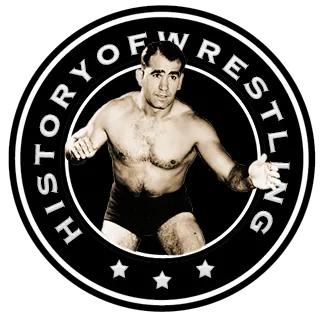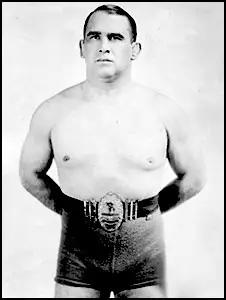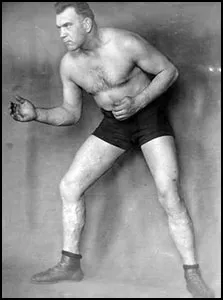May 4, 1931, Montreal, Quebec
The era of the 1920s & 1930s was unquestionably the most genuinely tumultuous and chaotic period in the long history of professional wrestling, with phantom title switches, questionable championship reigns, double-crosses, and promotional skulduggery being the rule of the day. And, without question the 1931 World title bout between Ed “Strangler” Lewis vs. Henri DeGlane is one of the most notorious examples of that professional subterfuge. Originally dubbed “The Battle of the Bite,” the infamous Canadian encounter has since come to be known as “The Original Montreal Screwjob.”
On December 10, 1930, Paul Bowser raised the ire of his promotional allies, Billy Sandow and Ed Lewis, by placing the prestigious AWA World championship around the waist of Ed Don George without their knowledge or consent. Since Lewis & Sandow had been at war (along with Bowser) against Jack Curley & Jim Londos, who controlled the sport’s other major world championship, Bowser’s unexpected title switch effectively shut Sandow & Lewis out of the decision-making process as it pertained to both the AWA and NWA/NYSAC World Heavyweight championships. It appeared that Sandow & Lewis, two-thirds of the legendary Gold Dust Trio and two of the most powerful men in the industry, had been humbled by Paul Bowser’s unexpected power play…just as Bowser had intended.
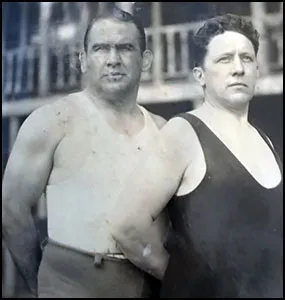
Lewis & Sandow
For the next several months, the two partners played along with this notion, enduring a great deal of gloating in locker rooms throughout the Northeast as Lewis “played ball” by doing jobs for Bowser’s men while patiently awaiting the opportunity both he and Sandow knew would eventually come their way. That opportunity presented itself on April 14, 1931 when Bowser booked a title match between The Strangler and Ed Don George in Los Angeles, a city where Lewis had a long history of drawing large crowds. Although he had agreed ahead of time to lose the match, Lewis had no intention of doing so and informed George of this just as the bout was set to begin. Given the choice of losing either “the hard way or the easy way” and knowing that he could not defeat Lewis in a legitimate contest, George acquiesced and Ed “Strangler” Lewis walked out of L.A. the new World champion. Back in Boston, Paul Bowser was understandably livid about losing control of his lucrative World title and he immediately began planning his revenge.
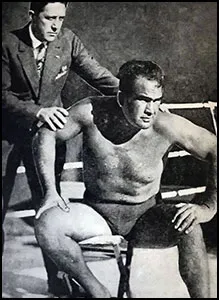
Sandow & Lewis
The cagey promoter got his opportunity on May 4, 1931 in Montreal, Quebec, when Lewis faced former Olympic gold medalist (and Bowser protégé) Henri DeGlane in a two-of-three-falls title match. As planned, Lewis dropped the first fall to DeGlane and the two wrestlers then retired to their respective locker rooms for the customary intermission. It was during this time that DeGlane (or possibly Dan Koloff, who was one of Paul Bowser’s associates) allegedly bit himself near the armpit, leaving teeth marks and drawing blood. He then returned to the ring, keeping the wound concealed, and began wrestling the second fall. However, after a going for a pin attempt, DeGlane jumped up in a frenzy, screaming that Lewis had bitten him. When referee Eugene Tremblay inspected DeGlane’s wound, he saw legitimate, bloody bite marks and immediately disqualified Lewis, awarding DeGlane the match and, more importantly, the World title.
Much like the second “Montreal Screwjob” in 1997, some would go on to dispute the legitimacy of the match’s outcome, feeling that the entire debacle had been a staged “work.” Nearly one hundred years after the fact, questions have been raised by informed parties as to why Lewis would have agreed to face DeGlane, a member of Bowser’s troupe, in a city controlled by Bowser, less than a month after “stealing” the title from Ed Don George? Additionally, why would Lewis agree to drop the first fall to DeGlane, thus effectively forfeiting control of the match? Although both men had agreed ahead of time that Lewis would be the victor, why would Lewis and Sandow, who were both highly protective of Lewis’ title and reputation, drop their guard against Bowser’s man, who also happened to be an Olympic gold medalist, in Bowser’s town? There is also a great deal of supposition regarding the role of referee Eugene Tremblay. Many respected wrestling historians are split on this subject, with some believing that Tremblay had no idea about the plot to steal the title from Lewis while others feel the evidence shows that there’s no way he could not have been in on the plan.
Although the match is mired in confusion and conjecture that, realistically, can never be proven one way or the other, two things are for sure: first, the (alleged) double-cross in 1931 resulted in yet another split in the World Heavyweight championship lineage that would take years to restore. Athletic Commissions in Illinois, Kansas, Oklahoma, and California continued to recognize Lewis as champion while DeGlane was viewed as the titleholder in the Northeast as well as other parts of the country and in Canada. Secondly, the match’s outcome led to the decision, which still remains to this day, to disallow a championship from changing hands via disqualification.
